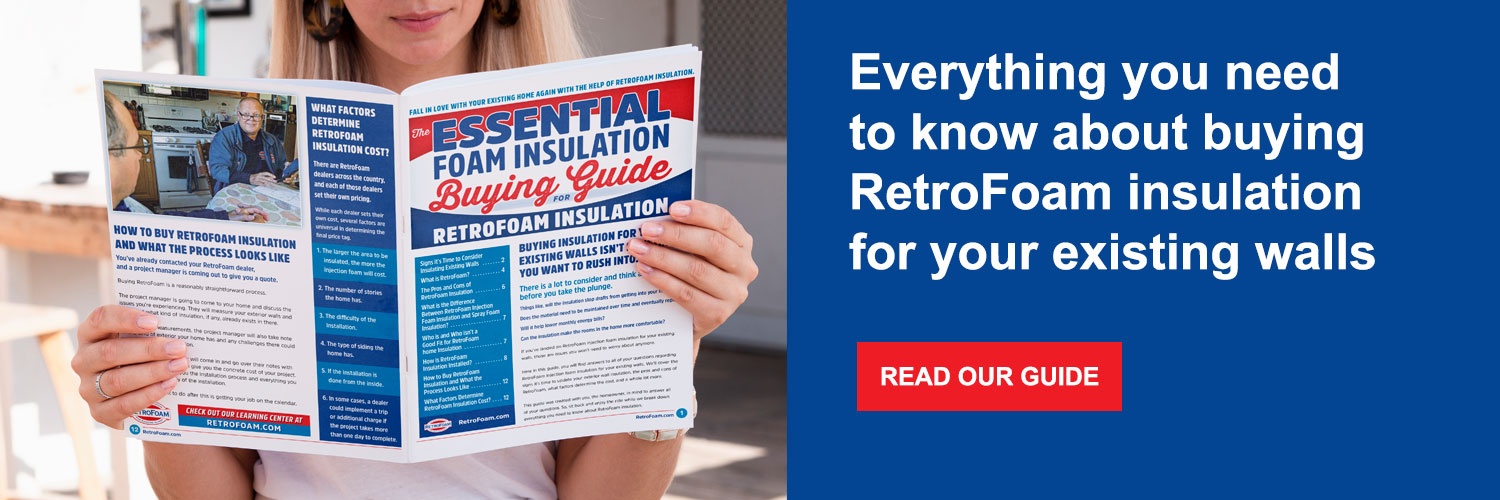Comparing RetroFoam vs. Fiberglass vs. Cellulose Insulation Performance (and Why R-Value Doesn't Tell the Whole Story)
injection foam insulation | RetroFoam insulation | energy efficiency


Not all insulations are created equal – they all perform differently and have their own perks.
In your research on all things home insulation, you’ve likely seen there are some differences between injection foam, like RetroFoam insulation, and traditional materials like fiberglass and cellulose. Sure, there are differences in what they’re made of, but what is the big difference in how they perform?
RetroFoam has been around as an existing wall insulation option for more than 35 years. In that time, we have offered something that traditional insulation can’t, but we’ll go more in-depth on that in just a bit.
You have questions, and we have answers. One of our main goals is to educate homeowners who want to broaden their knowledge of home insulation. This article will discuss the performance values of RetroFoam insulation and how it stacks up compared to fiberglass and cellulose.
RetroFoam Insulation Performance Versus Traditional Insulation
For this insulation performance comparison, what we’re really going to look at is whether the material can make your home more comfortable as well as energy-efficient.
Let’s take a look at the R-Value of fiberglass, cellulose, and RetroFoam. After that, we’ll discuss how these materials perform.
Fiberglass and Cellulose Insulation R-Value
First, it’s important to understand how R-Value works for fiberglass and cellulose.
For these materials, they slow heat loss through conduction, which is through touch.
The R-Value for fiberglass per inch is R-2.9 to R-3.8 for batts and R-2.2 to R-2.9 for loose-fill.
Loose-fill cellulose has an R-Value of R-3.1 to R-3.8 per inch.
R-Value measures an insulation’s thermal resistance. Thermal resistance is the material’s ability to resist that heat transfer through conduction.
But in the case of injection foam insulation, R-Value doesn’t tell the whole story.
RetroFoam Insulation R-Value
Traditional insulation slows heat loss through conduction, but RetroFoam stops heat loss through not only conduction but through convection as well.
Convection is heat loss through air movement. RetroFoam insulation stops any and all air movement in your existing walls with the air seal it creates. We’ll get more into that air seal and how it affects performance in just a second.
The R-Value of RetroFoam is R-4.6 to R-5 per inch. That’s a pretty good R-Value, but what you really want to pay attention to is that air seal. This is why R-Value doesn’t tell the whole story when it comes to the performance of RetroFoam insulation -- R-Value doesn’t take into account the air seal the injection foam creates.
That air seal stops air movement into and out of the home.
Fiberglass and Cellulose Insulation Performance
Fiberglass and Cellulose can both slow down the air movement into and out of your home.
That’s great, but they don’t completely stop the air from getting into your home.
If air can still move freely into and out of your home, then you will still be dealing with uncomfortable rooms and high energy bills. Not only those issues, but other problems could also pop up, like the growth of mold and mildew from condensation forming on your exterior walls.
When you talk about performance, you also have to keep in mind how long it will last. Both fiberglass and cellulose tend to shift, sag, and settle over time. As these materials age, they are leaving you with gaps in your insulation coverage.
At some point, you’ll need to replace both materials just to make sure you maintain the insulation coverage your home needs.
RetroFoam Injection Foam Insulation Performance
RetroFoam home insulation in your existing walls creates an air seal that isn’t possible with traditional insulation.
That air seal trumps a high R-Value every time because it completely stops air movement. The performance of foam insulation will stop uncomfortable drafts coming in through the walls, unstable temperatures in your home, and it will lower your monthly energy bills.
The lifespan of foam insulation also lends itself to its performance.
RetroFoam insulation will last for the life of your home. It doesn’t break down, shift, or sag, so you never have to replace it or add more material to it to make sure you have enough insulation coverage.
Adding High-Performance Foam Insulation to Your Home
After reading this comparison, you might be sold on adding RetroFoam insulation to your existing walls.
Don’t let that deter you on your educational journey, though. Head on over to our Learning Center, where you can learn more about how RetroFoam works, how much you can save on energy bills, and so much more.
Related Articles
What are the Best Exterior Wall Insulation Options?
Clearing Up Misconceptions About Injection Foam Insulation
What is the Difference Between RetroFoam Injection Foam and Spray Foam Insulation?
About Amanda Emery
Amanda previously has worked as a breaking news and crime reporter, TV news producer, and editor. As a journalist, she has won several awards from The Society of Professional Journalists - Detroit Chapter and the Michigan Press Association. Amanda uses her experience as a journalist to write content that will help educate homeowners on foam insulation benefits. When Amanda isn’t writing, she’s spending time with her husband Chris, daughter Lilith-Maeve, and rescued huskies Danger and Wendigo. She also loves knitting, making art, and cooking.


